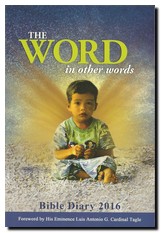THE WORD
FIRST READING: Acts 10, 34.37-43
Then Peter proceeded to speak and said, what has happened all over Judea, beginning in Galilee after the baptism that John preached, how God anointed Jesus of Nazareth with the holy Spirit and power. He went about doing good and healing all those oppressed by the devil, for God was with him. We are witnesses of all that he did both in the country of the Jews and (in) Jerusalem. They put him to death by hanging him on a tree. This man God raised (on) the third day and granted that he be visible, not to all the people, but to us, the witnesses chosen by God in advance, who ate and drank with him after he rose from the dead. He commissioned us to preach to the people and testify that he is the one appointed by God as judge of the living and the dead. To him all the prophets bear witness, that everyone who believes in him will receive forgiveness of sins through his name.”
SECOND READING: Col 3, 1-4
Brothers and sisters: If then you were raised with Christ, seek what is above, where Christ is seated at the right hand of God. Think of what is above, not of what is on earth. For you have died, and your life is hidden with Christ in God. When Christ your life appears, then you too will appear with him in glory.
or 1 Cor 5, 6-8
Your boasting is not appropriate. Do you not know that a little yeast leavens all the dough? Clear out the old yeast, so that you may become a fresh batch of dough, inasmuch as you are unleavened. For our paschal lamb, Christ, has been sacrifi ced. Therefore let us celebrate the feast, not with the old yeast, the yeast of malice and wickedness, but with the unleavened bread of sincerity and truth.
GOSPEL: Jn 20, 1-9
On the first day of the week, Mary of Magdala came to the tomb early in the morning, while it was still dark, and saw the stone removed from the tomb. So she ran and went to Simon Peter and to the other disciple whom Jesus loved, and told them, “They have taken the Lord from the tomb, and we don’t know where they put him.” So Peter and the other disciple went out and came to the tomb. They both ran, but the other disciple ran faster than Peter and arrived at the tomb first; he bent down and saw the burial cloths there, but did not go in.
When Simon Peter arrived after him, he went into the tomb and saw the burial cloths there, and the cloth that had covered his head, not with the burial cloths but rolled up in a separate place. Then the other disciple also went in, the one who had arrived at the tomb first, and he saw and believed. For they did not yet understand the scripture that he had to rise from the dead.
IN OTHER WORDS
It has been a perennial comment that Mary of Magdala was the first herald of the Resurrection, for as a woman she knew how to spread the news! Today, I am again confronted with the question, how did she became the first herald of good news? My reflection leads me only to one answer because she was among the very few that stood by Jesus until his last moments before dying, and Mark’s gospel testifies that she was at the burial place, too. (Mk 15:42)
The best heralds of good news are those who have seen how another person struggled to get to victory. They have experienced how another person entered darkness, yet they stood by. Easter is the time when our gratitude focuses on those beloved who stood by us through thick and thin of life. Easter is also the time when we become grateful because we have been given the grace to be a support to a beloved both in good and bad times.
Only the gospel according to John mentions “the cloth that had covered his head”. What was that? The cloth that covered his head covered his face. For all who did not believe in Jesus and condemned him, his Passion and Death prove that he failed. He lost face! Shame on him who claimed to be God! But the Resurrection is a living proof that he won over death. The Resurrection allowed Jesus to leave behind the cloth that covered his face. Tragedy becomes comedy.
Only the person who does not have to cover one’s face because of shame can be a herald of the good news. Mary Magdala had failures in the past; but in life she met the Jesus who enabled her to live again, giving her another chance. Jesus restored her self-respect and dignity, and she with
the grace of the Resurrection brought it to fulfillment. As the old adage goes, “Heaven and hell are full of sinners; but the difference is that those who are in heaven, believed again in themselves, in others, and in God!”
- Fr. Bernard Espiritu, SVD | New Zealand
The Word in other words 2016
An annual project of Logos Publications, The WORD in Other Words Bible Diary contains daily scripture readings and reflections written by priest, brothers, and sisters of the three congregations founded by St. Arnold Janssen (the SVD, SSpS, and SSpSAP). It hopes to serve as a daily companion to readers who continually seek the correlation of the Word of God and human experience.


